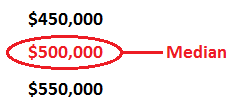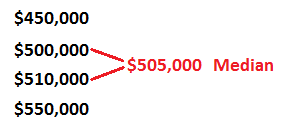Misleading medians

| Topics: | Medians, Statistical anomalies, Real capital growth, Supply and demand, Heavy developer activity |
| Author: | Jeremy Sheppard |
| Date: | 10 April 2015 |
Hands up if you've ever seen a report of the top growth suburbs for the last 12 months? Heaps of times right? And they're always ridiculously high like 40% or even 50%. It is utter B.S. It is quite pure and simply median price anomalies. It is not real capital growth.
Many investors blindly look at median prices not realising how misleading they can be. I remember getting into trouble with medians when I was a novice investor. I thought I could easily find markets with upwards of 30% capital growth per annum. I even based some short-term financing on this nonsense.
What is the median?
The median is the middle figure of a set of figures when placed in order.
So if three houses sell, the middle price is the median...

Some data providers won't publish a median if there have been too few sales since it is considered statistically unreliable. Other data providers take the approach that the median is the median even if there is only one sale.
Note that if 4 properties sell, there is no middle price.
This is the case for any even number of sales, 2, 4, 6, 8, etc.
So in this case the median is usually calculated as the average of the two middle figures...

Misleading median example
Imagine a sleepy little regional town with old two bedroom fibro shacks on
small blocks that were perhaps knocked up 60 years ago.
They may sell for $200,000 every now and then.
Here is what the median might look like in January of a typical year...

The median would of course be $200,000.
Now imagine a developer recognises the area as having some profit potential since the presiding council is amenable to new developments. The developer clears some land and creates large fully landscaped blocks with double brick 4 bedroom double storey houses with 2 bathrooms and double lock-up garages.
Since these new houses are so much better than the old houses,
they sell for a lot more. Let's say they sell for $400,000.
And since they're new, a lot of them do sell.
So you might see in the next month the following sale figures...

You can see that the median now in February is double that in January. Typically investors would interpret this as 100% capital growth in one month!
Actually there has been no capital growth at all in either type of housing market, new or old. All that has happened is the median has shifted upwards because of the heavy developer activity.
Median growth is not capital growth in this case.
What causes such anomalies?
The previous example is an extreme case and a purely theoretical one. But you can see that a real case would not be so hard to come across. Over the course of a year, it would not be hard to see a gradual shift in median values if there is heavy developer activity.
A new 2 bedroom unit will always sell for more than an old 2 bedroom unit right next door. New is almost always more expensive than old. Have a look at almost any development project and you'll see this common theme.
The one thing that is more likely to cause this sudden rise in medians, and also sudden fall, is two different markets within the one market.
For example, a unit market will have sub-markets of: 1 bedroom, 2 bedroom and even 3 bedroom units. Even in the same complex, they will have radically different prices. But the median reported will often be "units".
Publishing a median for 1 bedroom units and another median for 2 bedroom units and another for 3 bedroom units is not the answer. Another problem arises when splitting the sales up into smaller similar parcels. The smaller the sample size, the less reliable the figure will be.
As mentioned before there are new 2 bedroom units and old ones. They can have very different prices. Similarly, you can have a renovated old unit and an un-renovated old unit, again very different prices.
Some novice data providers have tried to publish at this level of granularity and the figures have been absurd. A larger sample size yields much more accurate results. But even large sample sizes don't tell the full story.
How frequently do anomalies occur?
Every month I see new publications of the fastest growing property markets in the country. I ignore them as I know the top growth markets by median value change are invariably statistical anomalies.
Some enterprises offer reports on the fastest growing markets using median values as the gauge. They offer the report for free but value it at some ridiculous price like $487. The report is not just worthless, it is actually misleading. So its value should probably be negative.
One of the most common occurrences of this misleading median anomaly is where there is heavy developer activity, especially in older markets.
Note that when a large amount of accommodation is supplied to an area through developer activity, you'll also get an increase in population. An increase in sales volume is also likely.
Some data providers and other experts will point to increased population growth and increased sales volume as an indicator of coming capital growth. In some cases this may be true, but in many it is a trap.
What's an investor to do?
The only thing investors can do is question each dubious statistic they see. Check for heavy developer activity in a location. Check property listing sites like realestate.com.au to see if the majority of properties being sold are in the same category: new vs old, same bedroom count, block size, and so on.
In markets dogged by median anomalies you'll see the median jump up one month and drop just as dramatically possibly the next month. This is often the case in markets that have a broad range of different types of the same property class.
The easy solution here is to examine an historical chart. There will be ups and downs, but the line of best fit will tell a more reliable story.
From here: